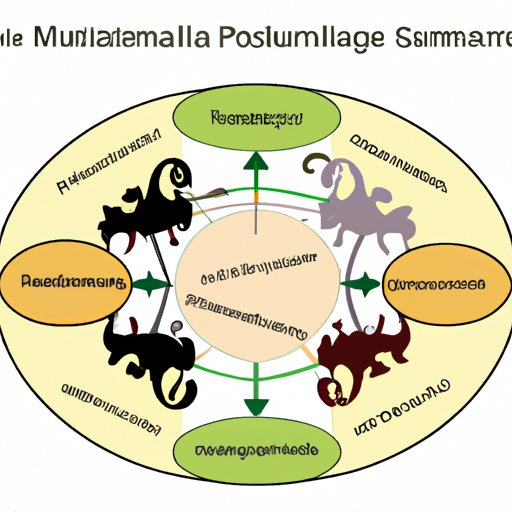Introduction
Mutualism in science refers to the relationship between two species, where each benefits from the other. It is an example of symbiosis – a close and long-term interaction between two different species – and is one of the most important processes that maintain the balance of nature. Mutualism plays a critical role in ecosystems, as it helps species survive and thrive in a variety of environments.
Definition and Examples of Mutualism in Science
The term “mutualism” was first used by Pierre-Joseph van Beneden in 1876 to describe the relationship between two organisms that interact in a beneficial way. In biology, mutualism is defined as a relationship between two species in which both benefit from the interaction. Examples of mutualism include the relationship between bees and flowers, where bees collect nectar and pollen, while the flower gets pollinated; or the relationship between ants and acacia trees, where ants defend the tree against herbivores, while the tree provides food for the ants.

Overview of the Role of Mutualism in Ecosystems
Mutualism is an important part of natural ecosystems, as it enables species to survive in different environments. Mutualistic relationships help species adapt to changing conditions, allowing them to coexist in habitats that would otherwise be too hostile for either species to survive on its own. For instance, certain species of fungi and bacteria form a mutualistic relationship with plants, providing them with essential nutrients, such as nitrogen and phosphorus, in exchange for sugars produced by photosynthesis. This relationship allows plants to survive in nutrient-poor soils.
Mutualism Helps Species Survive
Mutualism is essential for the survival of many species, as it allows them to adapt to different environments and access resources that are otherwise unavailable. Studies have shown that species involved in mutualistic relationships tend to be more successful in terms of survival and reproduction than those that do not engage in mutualism. As Dr. Mark Ritchie, professor of Evolutionary Biology at the University of Edinburgh, states: “Mutualisms can be incredibly important for the survival of species, providing them with essential resources or protection from predators.”
Insights from Evolutionary Biology
Evolutionary biologists have studied the role of mutualism in species survival for decades. Studies have shown that mutualisms can evolve over time, allowing species to become more adapted to their environment and better equipped to survive. For instance, research has found that some species of birds and plants have evolved a mutualistic relationship that enables them to access resources that are otherwise inaccessible. This relationship allows the birds to feed on the fruits of the plant, while the plant benefits from the dispersal of its seeds.
Symbiotic Relationships in Nature
Mutualism is a common phenomenon in nature, with countless species engaging in symbiotic relationships. Studies have found that these relationships are highly complex, with a range of benefits for both species. For instance, some species of ant and aphid form a mutualistic relationship, where the ants protect the aphids from predators and parasites, while the aphids provide the ants with nutritious honeydew. Similarly, many species of fish, such as clownfish, form a mutualistic relationship with anemones, where the clownfish cleans the anemone and protects it from predators in exchange for shelter.
Benefits of Mutualism
Mutualism offers a range of benefits to both species involved. From an ecological perspective, mutualistic relationships can help maintain the balance of nature by ensuring that species have access to the resources they need to survive. Additionally, mutualism can help species adapt to changing conditions and enable them to thrive in different environments. As Dr. Ritchie states: “Mutualisms can act as a buffer against environmental change, allowing species to survive even when conditions are less than ideal.”
Interdependent Relationship between Organisms
Mutualism is also important because it demonstrates the interdependent relationship between organisms. By engaging in a mutually beneficial relationship, species can access resources that would otherwise be inaccessible, allowing them to survive and thrive in different environments. As Dr. Ritchie notes: “Mutualisms demonstrate the intricate web of life, showing how species rely on each other for survival.”
Conclusion
Mutualism is an important process in science, as it helps species survive and thrive in different environments. Mutualistic relationships can form between different species, allowing them to access resources that would otherwise be inaccessible. These relationships help maintain the balance of nature and demonstrate the interdependent relationship between organisms. Overall, mutualism plays a critical role in ecosystems, and understanding its importance can help us better manage our environment.
Resources
Books, Articles and Websites for Further Reading on Mutualism in Science:
- Meyer, J., & Schmitt, T. (2008). Mutualism: Ecology and Evolution. Cambridge University Press.
- Levin, S.A. (1975). The Theory of Mutualism. Annual Review of Ecology and Systematics, 6(1), 339–357.
- Ritchie, M.E. (2007). Mutualism and the Structure of Ecological Communities. Oxford University Press.
- National Geographic: Mutualism
-
(Note: Is this article not meeting your expectations? Do you have knowledge or insights to share? Unlock new opportunities and expand your reach by joining our authors team. Click Registration to join us and share your expertise with our readers.)
